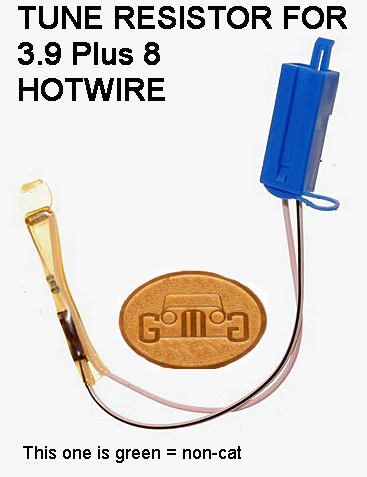Tune Resistor by Lorne Goldman
A Tune Resistor was originally specified in the wire harness so that one
basic ECU could serve multiple vehicle markets. (Multiple
computer programs could be stored within the ECU, and the ECU could
"decide" which one to use based on what  tune
resistor it sensed.) One wire of the Tune Resister was wired to
terminal 5 of the ECU plug, and its other wire was connected to a
ground/earth or terminal 27 which is (duh!) the plug's ground (Black
wire with grey tracer)
tune
resistor it sensed.) One wire of the Tune Resister was wired to
terminal 5 of the ECU plug, and its other wire was connected to a
ground/earth or terminal 27 which is (duh!) the plug's ground (Black
wire with grey tracer)
At some point during 14CUX production, Rover apparently decided to
eliminate the Tune Resistor. It isn't clear from the
literature whether any Overseas market 14CUX systems would be effected by
having an incorrect or damaged tune resister. Most
Efi 'Hot wire' systems will incorporate a Tune resistor. I have never
found one without but they supposed to NOT exist in the much later production.
(pity) Their function is to make sure the vehicle runs the correct installed fuel
map in the ECU for Cat or Non cat vehicles. When you locate yours
the following will be relevant:
The following information is based on Land Rover literature.
White wire 3900 Ohms USA and European vehicles with catalytic converters
Green wire 470 Ohms UK and European vehicles without catalytic converters
Yellow wire 910 Ohms Saudi vehicles (without catalytic converters.)
Red wire 180 Ohms Australia and "the rest of the world."
Note: all four types of Rover Tune Resistors were rated for 0.5 Watts.
When connected, the tune resistor switches the ECU to the relevant fuel map. When visually inspecting the EFI Cable Harness Assembly, this resistor can be conspicuous BUT do not confuse it with the Land Rover transducer.This circuit is the only connection
between the ignition system and the fuel injection system. A damaged or
loosely connected resistor would likely result in an open circuit,
leaving the ECU wondering about engine speed and forcing it in the a hyper-rich "limp home mode".
There were some EFi looms made after 1990 with
the tune resistor black taped inside rather than visible...merely feel along the loom.. Where the tune resistor is fitted externally, it
will be where the relays sprout out of the loom, not by the ECU.
A Green tune resistor (green referring to the color of the
wires) will always give a non-cat tune, and White is always a cat tune.
By the way, the default (Limp Home) tune is a cat map, so this usually
makes a non-cat car run very rich.
You need to run
the correct tune resistor to get the correct fuelling from your ECU and
you need to re-chip all Hotwire ECUs and if you have upgraded your
engine spec in any way...as in increasing capacity or changing cam, and
even for stock engines, the Optimax chip (2022 now defunct but the Tornado chip is the same map..merely extended) chip will refine your efficiency, economy and performance.
For those 'Even More' technical.
A tune resistor should be connected between pins 5 and 27. The wire
colors are Black/White and Black/Grey (where the first color is the
primary color, and the second is the trace). The Green tune resistor
value is 470 Ohms, and White tune is 3900 Ohms. Ordinary 1/2 Watt
resistors are just fine, although the originals were Metal Oxide 2% item
(which I always use anyway). In this location I sometimes use a 1 Watt
resistor, because the larger physical size makes them easier to handle.
Finding Your Tune Resistor (watch only from Minute1:40 on)
 tune
resistor it sensed.) One wire of the Tune Resister was wired to
terminal 5 of the ECU plug, and its other wire was connected to a
ground/earth or terminal 27 which is (duh!) the plug's ground (Black
wire with grey tracer)
tune
resistor it sensed.) One wire of the Tune Resister was wired to
terminal 5 of the ECU plug, and its other wire was connected to a
ground/earth or terminal 27 which is (duh!) the plug's ground (Black
wire with grey tracer)  tune
resistor it sensed.) One wire of the Tune Resister was wired to
terminal 5 of the ECU plug, and its other wire was connected to a
ground/earth or terminal 27 which is (duh!) the plug's ground (Black
wire with grey tracer)
tune
resistor it sensed.) One wire of the Tune Resister was wired to
terminal 5 of the ECU plug, and its other wire was connected to a
ground/earth or terminal 27 which is (duh!) the plug's ground (Black
wire with grey tracer)